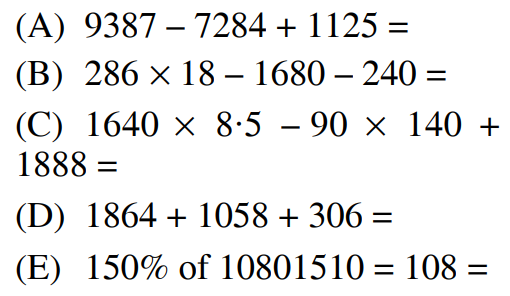Which of the following is not equal to the others?
68
1216
1525
1824
The correct Answer is:C
To determine which of the following fractions is not equal to the others, we will simplify each fraction step by step.
Step 1: Simplify the first fraction, 6/8.
- To simplify 6/8, we find the greatest common divisor (GCD) of 6 and 8, which is 2.
- Divide both the numerator and the denominator by 2:
6÷28÷2=34
Step 2: Simplify the second fraction, 12/16.
- The GCD of 12 and 16 is also 4.
- Divide both the numerator and the denominator by 4:
12÷416÷4=34
Step 3: Simplify the third fraction, 15/25.
- The GCD of 15 and 25 is 5.
- Divide both the numerator and the denominator by 5:
15÷525÷5=35
Step 4: Simplify the fourth fraction, 18/24.
- The GCD of 18 and 24 is 6.
- Divide both the numerator and the denominator by 6:
18÷624÷6=34
Step 5: Compare the simplified fractions.
- The simplified fractions are:
- 6/8 = 3/4
- 12/16 = 3/4
- 15/25 = 3/5
- 18/24 = 3/4
From the comparison, we see that:
- 6/8, 12/16, and 18/24 all simplify to 3/4.
- 15/25 simplifies to 3/5.
Conclusion:
The fraction that is not equal to the others is 15/25.
---
- To simplify 6/8, we find the greatest common divisor (GCD) of 6 and 8, which is 2.
- Divide both the numerator and the denominator by 2:
6÷28÷2=34
- The GCD of 12 and 16 is also 4.
- Divide both the numerator and the denominator by 4:
12÷416÷4=34
- The GCD of 15 and 25 is 5.
- Divide both the numerator and the denominator by 5:
15÷525÷5=35
- The GCD of 18 and 24 is 6.
- Divide both the numerator and the denominator by 6:
18÷624÷6=34
- The simplified fractions are:
- 6/8 = 3/4
- 12/16 = 3/4
- 15/25 = 3/5
- 18/24 = 3/4
- 6/8, 12/16, and 18/24 all simplify to 3/4.
- 15/25 simplifies to 3/5.
The fraction that is not equal to the others is 15/25.
Topper's Solved these Questions
- FRACTIONS AND DECIMALS BOOK - NCERT EXEMPLARCHAPTER - FRACTIONS AND DECIMALS EXERCISE - EXERCISE (FILL IN THE BLANKS)
24 Videos
- FRACTIONS AND DECIMALS BOOK - NCERT EXEMPLARCHAPTER - FRACTIONS AND DECIMALS EXERCISE - EXERCISE (TRUE OR FALSE )
21 Videos
- FRACTIONS AND DECIMALS BOOK - NCERT EXEMPLARCHAPTER - FRACTIONS AND DECIMALS EXERCISE - ACTIVITY
1 Videos
- DATA HANDLINGBOOK - NCERT EXEMPLARCHAPTER - DATA HANDLINGEXERCISE - Exercise
66 Videos
- GEOMETRYBOOK - NCERT EXEMPLARCHAPTER - GEOMETRYEXERCISE - Exercise
56 Videos
Similar Questions
Knowledge Check
Which of the following is equal to 'a'?
Aa106−a46B.12√(a4)1/3C(√a3)23Da127×a712Which of the following is equal to 9?
A√729B3√729C3√729D(3)3Which of the following is equal to 1? (0.11)2(1.1)2×0.1 (b) (1.1)2112×(0.01)2 (c) (0.011)2(1.1)2×(0.01)2 (d) (0.11)2112×0.01
A(0.11)2(1.1)2×0.1B(1.1)2112×(0.01)2C(0.11)21.12×0.012D(0.11)2112×0.01
Which of the following is equal to integer ?
View SolutionFour of the five parts lettered (A),(B),(C ),(D) and (E ) in the following equations are exactly equal.Which of the part is not equal to the other four ? The letter of that part is the answer --

View Solutionwhich of the following is equal to x ?
View SolutionWhich one of the following is not related to other options?
View SolutionWhich of the following is least related to the other three ?
View Solution
